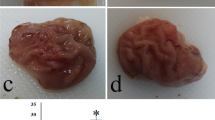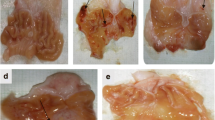Abstract
This study determined the role that oxygen-derived free radicals played in the production of gastric injury in rats challenged orally with concentrated ethanol or subjected to vascular compromise. In the ethanol study, rats were pretreated with a variety of free radical scavengers or enzyme inhibitors prior to exposing the stomach to 100% ethanol. At sacrifice, the degree of macroscopic damage to the glandular gastric mucosa was quantified. In separate studies, the effects of ethanol on gastric mucosal levels of enaldehydes (malondialdehyde and 4-hydroxynonenal) were examined as an index of lipid peroxidation. Superoxide dismutase and catalase pretreatment were without benefit in reducing injury in our ethanol model, excluding potential contributory roles for the superoxide anion or hydrogen peroxide, respectively. Dimethyl sulfoxide and desferoxamine were likewise without protective capabilities, eliminating a role for the hydroxyl radical. Allopurinol, a xanthine oxidase inhibitor, provided no protection under acute conditions, even though partial protection was noted when administered chronically. Further, enaldehyde levels were not increased over control levels in alcohol-exposed mucosa, indicating no enhanced lipid peroxide formation. In contrast, in animals in which ischemia to the stomach was induced followed by reperfusion, marked gastric injury was observed in combination with enhanced enaldehyde levels. Prevention of enaldehyde formation by a 21-aminosteroid concomitantly prevented injury induced by ischemia-reperfusion. These findings support the conclusion that ischemia-reperfusion injury to the stomach is an oxygen-derived free radical process whereas ethanol-induced injury clearly involved some other process. Although allopurinal was partially protective against ethanol damage when administered chronically, observations in other models of injury suggest that this action is independent of its inhibitory effect on xanthine oxidase.
Similar content being viewed by others
References
Granger DN, Rutili G, McCord JM: Superoxide radicals in feline intestinal ischemia. Gastroenterology 81:22–29, 1981
Parks DA, Bulkely GB, Granger DN, Hamilton SR, McCord JM: Ischemic injury to the cat samll intestine: Role of superoxide radicals. Gastroenterology 82:9–15, 1982
Itoh M, Guth PH: Role of oxygen-derived free radicals in hemorrhagic-induced gastric lesions in the rat. Gastroenterology 88:1162–1167, 1985
Perry MA, Wadwa S, Parks DA, Pickard W, Granger DN: Role of oxygen radicals in ischemia-induced lesions in the cat stomach. Gastroenterology 90:362–367, 1986
Freeman BA, Crapo JD: Biology of disease free radicals and tissue injury. Lab Invest 47:412–423, 1982
Bulkely GB: The role of oxygen free radicals in human disease processes. Surgery 94(3):407–411, 1983
McCord JM: Superoxide radical: A likely link between reperfusion injury and inflammation. Adv Free Radic Biol Med 2:325–345, 1986
Reily PM, Schiller HJ, Bulkely GB: Reactive oxygen metabolites in shock.In Scientific American Surgery. DW Wilmer et al (eds). Scientific American Inc, 1992, pp 1–32
Pihan G, Regillo C, Szabo S: Free radicals and lipid peroxidation in ethanol- or aspirin-induced gastric mucosal injury. Dig Dis Sci 32(12):1395–1401, 1987
Smith GS, Barreto JC, Schmidt KL, Tornwwall MS, Miller TA: Protective effect of dimethylthiourea against mucosal injury in the rat stomach: Implications for hydroxyl radical mechanism. Dig Dis Sci 37:1345–1355, 1992
Halliwell B, Gutteridge JMC: Lipid peroxidation: A radical chain reaction.In Free Radicals in Biology and Medicine. Oxford, Clarendon Press, 1989, pp 188–276
Esterbauer H, Schaur RJ, Zollner H: Chemistry and biochemistry of 4-hydroxynononal, malondialdehyde, and related aldehydes. Free Radic Biol Med 11:81–128, 1991
Braughter JM, Hall ED, Jacobsen EJ, McCall JM, Means ED: The 21-aminosteroids: Potent inhibitors of lipid peroxidation for the treatment of central nervous system trauma and ischemia. Drugs Future 14:143–152, 1989
Laizure SC, Franklin LK, Kaiser DG, Williams CI, Stevens RC, Sanders PL, Miller M: Disposition of tirilazad (U7400GF), a 21-aminosteroid, in the plasma, heart, brain, and liver of the rat. Drug Met Dispos 21:951–954, 1993
Cross JM, Smith GS, Russell DH, Nguyen PH, Mercer DW, Barreto JC, Miller TA: Protective effect of a 21-aminosteroid against hemorrhage-induced ischemia-reperfusion injury in the rat stomach: Role of lipid peroxidation. Shock 3(5):385–390, 1995
Schmidt KL, Henegan JM, Smith GS, Hilburn PJ, Miller TA: Prostaglandin cytoprotection against ethanol-induced gastric injury in the rat. Gastroenterology 88:649–659, 1985
Schmidt KL, Smith GS, Miller TA: Microscopic correlates of adaptive cytoprotection in an ethanol injury model. Histol Histopathol 4:105–115, 1989
Till GO, Guilos LS, Mahrougui M, Friedl HP, Trentz O, Ward PA: Role of xanthine oxidase in thermal injury of the skin. Am J Physiol 135(1):195–202, 1989
Braughler JM, Pregenzer JF: The 21-aminosteroid inhibitors of lipid peroxidation: Reactions with lipid peroxyl and phenoxy radicals. Free Radic Biol Med 7:125–130, 1989
Valenzuela A: The biological significance of malondialdehyde determination in the assessment of tissue oxidative stress. Life Sci 48:301–309, 1991
Bradford MM: A rapid and sensitive method for quantitation of microgram quantities of proteins utilizing the principle of dye binding. Anal Biochem 72:248–254, 1976
Granger DN, Hernandez LA, Grisham MB: Reactive oxygen metabolites: Mediators of cell injury in the digestive system. Viewpoints Dig Dis 18(4):13–16, 1986
Boyce NW, Holdsworth SR: Hydroxyl radical mediation of immune renal injury by desferrioxamine. Kid Int 30:813–817, 1986
Smith SM, Grisham MB, Manes EA, Granger DN, Kvietys PR: Gastric mucosal injury in the rat: Role of iron and xanthine oxidase. Gastroenterology 92:950–956, 1987
Parks DA, Granger DN: Xanthine oxidase: Biochemistry, distribution, and physiology. Acta Physiol Scand 548:87–99, 1986
Pihan G, Majzoubi D, Handenschild C, Trier JS, Szabo S: Early microcirculatory stasis in acute gastric injury in the rat and prevention by 16, 16-dimethyl prostaglandin E2 or sodium thiosulfate. Gastroenterology 91:1415–1426, 1986
Ohya Y, Guth PH: Ethanol-induced gastric mucosal blood flow and vascular permeability changes in the rat. Dig Dis Sci 33(7):883–888, 1988
Godin DV, Bhimji S: Effects of allopurinol on myocardial ischemic injury induced by coronary artery ligation and reperfusion. Biochem Pharmacol 36(13):2101–2107, 1987
Godin DV, Bhimji S, McNeill JH: Effects of allopurinol pretreatment on myocardial ultrastructure and arrhythmias following coronary artery occlusion and reperfusion. Virchows Arch (Cell Pathol) 52:327–341, 1986
Peterson DA, Kelly B, Gerrard JM: Allopurinol can act as an electron transfer agent. Is this relevant during reperfusion injury? Biochem Biophys Res Commun 137:76–79, 1986
Ziegelstein RC, Zweier J, Mellits EP, Younes A, Lakatta EG, Stern MD, Silverman HS: Dimethylthiourea, an oxygen radical scavenger, protects isolated cardiac myocytes from hypoxic injury by inhibition of Na+-Ca+ exchange and not by its antioxidant effects. Circ Res 70(4):804–811, 1991
Shook LA, Paully TH, Marple SL, Herstman SJ, Tai HH, Bandy BD, Gillespie MN: Group B streptococcus promotes oxygen radical dependent thromboxane accumulation in young piglets. Pediatr Res 27(4):349–352, 1990
Author information
Authors and Affiliations
Rights and permissions
About this article
Cite this article
Smith, G.S., Mercer, D.W., Cross, J.M. et al. Gastric injury induced by ethanol and ischemia-reperfusion in the rat. Digest Dis Sci 41, 1157–1164 (1996). https://doi.org/10.1007/BF02088232
Received:
Revised:
Accepted:
Issue Date:
DOI: https://doi.org/10.1007/BF02088232




